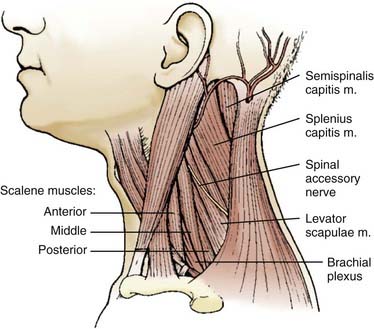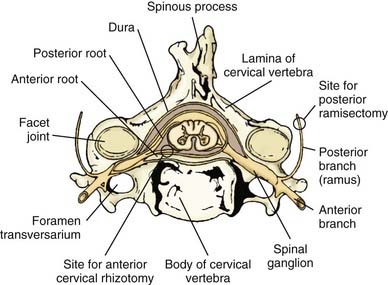CHAPTER 85 Selective Peripheral Denervation for Cervical Dystonia
Selective peripheral denervation for the treatment of cervical dystonia (CD) consists mainly of sectioning the peripheral branch of the spinal accessory nerve to the sternocleidomastoid (SCM) muscle, combined with posterior ramisectomy from C1-6.1 The term selective peripheral denervation was coined by Bertrand, who also made the procedure popular in the 1970s.2 Although selective peripheral denervation is a safe procedure with minimal and infrequent side effects and proven efficacy, it is not performed widely because it requires particular expertise with regard to both the phenomenologic differential diagnosis of CD and the surgical techniques.
Cervical Dystonia
CD is the most common form of focal dystonia.3,4 Its prevalence has been estimated to be as high as 13 per 10,000 people in western countries. The mean age of onset is 41 years, and similar to other forms of focal dystonia, there is a female preponderance (about 2.2 : 1). In the vast majority of patients with CD, no underlying cause can be identified. In a few cases, CD is a manifestation of inherited primary dystonia. In some patients, a history of trauma or exposure to neuroleptic drugs is present.
The term cervical dystonia is now preferred and has replaced spasmodic torticollis, for several reasons4,5: few patients present with simple turning of the head; the abnormal movement is not always spasmodic; and, most important, nondystonic neck postures are also referred to as torticollis. CD affects predominantly the neck, including the anterior and posterior muscles. In some patients, the shoulder is involved as well. In approximately one third of patients, CD is one feature of a more widespread segmental dystonia that also involves the facial muscles or upper extremities. CD is characterized by involuntary, patterned, repetitive, and sustained tonic or phasic muscle contractions that result in abnormal movements or postures of the head and neck. Dystonic tremor consists of tremulous or jerking movements of the head that are more irregular than essential tremor. Symptoms are most evident when the patient attempts to move the head contralateral to the force of the dystonia. Most frequently, CD is accompanied by neck pain that may be severe and lead to further incapacitation. In many instances, patients employ a “sensory trick,” such as touching the chin, holding the neck, or other maneuvers, to decrease dystonic activity. Such tricks are also called gestes antagonistique.
Various basic patterns of CD are defined dependent on the posture of the head.4 Torticollis is defined as rotation of the head about the head-body axis (movement of the chin toward one shoulder in the horizontal plane); laterocollis is defined as a sideward tilt of the head (movement of the ear toward the ipsilateral shoulder); anterocollis is defined as flexion of the neck in the anterior-posterior axis; and retrocollis is defined as extension in the anterior-posterior axis. Lateral shift depicts translation of the axis of the head in the horizontal plane, and sagittal shift in the sagittal plane. Often a combination of these abnormalities is observed, with the pattern determined by the combination of cervical muscles involved (Fig. 85-1). It is important to understand which muscles may be involved based on the patient’s clinical presentation. Even more important when deciding which muscles to denervate is the fact that dystonic activity may vary to produce the individual pattern of dystonia in the same patient.6

FIGURE 85-1 Cervical muscles frequently involved in cervical dystonia.
(Redrawn from Brin MF, Jankovic J, Comella C, et al. Treatment of dystonia using botulinum toxin. In: Kurlan R, ed. Treatment of Movement Disorders. Philadelphia: Lippincott Williams & Wilkins; 1995:183-246.)
The differential diagnosis of CD includes a variety of nondystonic disorders.4 Pseudodystonia may be caused by atlantoaxial dislocation, degenerative disk disease, Klippel-Feil syndrome, pediatric posterior fossa tumors, trochlear palsy, Sandifer’s syndrome, and various other disorders. More systemic basal ganglia disorders should be excluded in patients with CD onset at a young age. Long-standing CD may result in enhanced degenerative cervical spine disease followed by cervical myelopathy and radiculopathy.7 Rarely, dystonic postures may lead to fixed deformities secondary to ossification of spinal ligaments or facet joints.8,9
The first-line treatment for CD is chemodenervation with botulinum toxin type A.3,4 The dose and the sites of injection must be individualized to obtain optimal results. The efficacy and safety of botulinum toxin have been demonstrated in several controlled and open-label trials. Most of these report improvement in about 90% of CD patients, with mild side effects in up to 28%.4 The effect of botulinum toxin is usually noted about 1 week after injection, and the average duration of the benefit is 3 to 4 months. In patients who are resistant to botulinum toxin A, botulinum toxin type B may be used, although the average duration of maximal improvement is much shorter and side effects are more frequent than with type A. Pharmacotherapy for CD consists mainly of anticholinergic drugs or muscle relaxants. Overall, medical therapy plays a minor role in the treatment of CD, although many patients benefit from treatment of the chronic pain associated with CD.
Development of Surgery for Cervical Dystonia
Surgical treatment for CD has a long history dating back to ancient Greece.1,5 Myotomies of the SCM were performed as early as 1641, and denervation of cervical muscles was achieved by 1834. Although intradural procedures initially involved sectioning of the posterior cervical roots, attention soon shifted to the anterior roots. McKenzie developed intradural sectioning of both the anterior upper cervical roots and the spinal accessory nerve in the 1920s. Dandy as well as Hamby and Schiffer further refined this procedure,10 which remained the most common surgical procedure for CD until the early 1990s.11,12 Because this “standard” procedure was rather nonselective and resulted in high complication rates, modifications were developed that aimed to denervate the dystonic muscles selectively while preserving normal activity. The results of these efforts were quite variable in terms of both safety and efficacy, but many studies claimed postoperative improvement in 60% to 90% of patients.10–13 It was unclear, however, to what extent the amelioration of abnormal postures or movements translated into improved function, particularly in light of the large number of side effects. A weak or unstable neck was estimated to occur in up to 40% of patients after bilateral rhizotomy.11 Transient dysphagia was noted in up to 30%. Better results with fewer side effects were seen with selective approaches targeting only those nerves supplying clearly dystonic muscles and with staging of the procedure.14
Microvascular decompression of the spinal accessory nerve has been attempted, based on the hypothesis that CD is analogous to vascular compressive disorders such as hemifacial spasm and trigeminal neuralgia. Pathophysiologic concepts do not support microvascular decompression as a valid treatment option for CD, however, and the outcome data are ambiguous; therefore, microvascular decompression cannot be recommended for the treatment of CD at this time.1,15 Similarly, cervical spinal cord stimulation for CD has been abandoned.16,17
Selective peripheral denervation, including posterior ramisectomy and spinal accessory nerve sectioning, was pioneered by Bertrand in the 1970s.2,18 Bertrand clearly demonstrated that this innovative operation was much more selective than the intradural procedures used in the past and entailed less risk. One of the main advantages of selective peripheral denervation is that it is a completely extraspinal, extradural procedure (Fig. 85-2). Further, the approach can be applied from C1-6 and can be performed unilaterally or bilaterally in one session. Over the past two decades, selective ramisectomy and peripheral denervation, sometimes combined with myotomy, have largely replaced intradural rhizotomy as the ablative procedure of choice for CD.19–26 Given its less favorable risk-benefit profile, intradural rhizotomy can no longer be recommended.15
Indications and Patient Selection for Selective Peripheral Denervation
Selective peripheral denervation is indicated in patients with CD who do not respond adequately to medical therapy and repeated botulinum toxin injections. It is estimated that 6% to 14% of patients with CD are primary nonresponders to botulinum toxin injections,3,4 and another 3% to 10% develop immunoresistance over time. In general, patients with predominantly tonic dystonia are better candidates for selective peripheral denervation than those with prominent phasic movements.1 Patients with marked myoclonus or dystonic head tremor are poor candidates for the procedure. In some patients selective peripheral denervation may serve as an adjunct or also as an alternative to continued botulinum toxin therapy.
It is crucial to tailor the denervation procedure to each patient’s symptoms. This may involve several successive operative steps as well as augmentative myotomy or myectomy.14,27 The primary goal is to selectively weaken the dystonic muscles while preserving normal muscle function, thereby avoiding side effects. The patient and the treating neurologist should be informed that staged procedures may be necessary to achieve an optimal result. The muscles with the most prominent dystonic activity are usually identified on clinical grounds by observing the pattern of the patient’s dystonia and directly palpating the neck muscles. Electromyography may be useful in some cases.28 In addition to the muscles usually involved in CD (SCM, trapezius, splenius, semispinalis), other muscles such as the levator scapulae, scalene, longus colli, and paraspinal erector trunci should be investigated.
There are several rating scales available to quantify the severity of both the movement disorder and the disease-specific disability in patients with CD.4 The most widely used is the Toronto Western Spasmodic Torticollis Rating Scale and its modifications. Subscales include measures of dystonia severity, pain, and disability. Another specific scale for CD is the Tsui Scale. Subscores of the Burke-Fahn-Marsden Dystonia Scale, Unified Dystonia Rating Score, and Global Dystonia Rating Scale are used as well. We also recommend standard videotaping of patients preoperatively.
Surgical Technique
Patients are operated on under general anesthesia. There have been several modifications of Bertrand’s original technique.21–2325 Both the posterior ramisectomy and the SCM denervation can be performed in one draping when the patient is positioned semisitting with the head fixed in a Mayfield head holder. However, because of the danger of air embolism,25 and because the only advantage of the semisitting position is the possibility of completing both procedures through one approach, most neurosurgeons prefer to perform the ramisectomy with the patient in the prone position and then the SCM denervation with the patient in the supine position.








